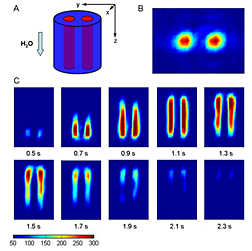| Research
|
The espresso maker is Elbio Dagotto's most trusted piece of equipment when it comes to creating sparks for scientific theory. The condensed matter physicist at DOE's Oak Ridge National Laboratory swears by the coffee machine so much that he bought several when he moved to Tennessee. He needed one for home, one for the Spallation Neutron Source and one for his office at the University of Tennessee. He just needed one wherever he was going to be. “You never know where you are going to get good ideas. You could be at home, in a plane or in your office,” Dagotto, says. “But a lot of good ideas come from talking with researchers from around the world, usually informally over a cup of coffee or something.” The future espresso breaks at the SNS excite Dagotto because he says that at least a fraction of the 2,000 users that the facility expects to host each year will share his research interests. As a condensed matter theorist, Dagotto finds himself trying to understand the properties of high-temperature superconductors, colossal magnetic resistance materials and nanomaterials. He says the new facility will not only bring beneficial collaboration for science and technology, but also intellectual expansion. Two other ORNL facilities also interested him—the Center for Nanophase Materials Sciences and the Center for Computational Sciences. Dagotto says his work, in very simple terms, centers on simulating what electrons are doing inside different materials, but because these particles act so exotically at the atomic level, that explanation is basic. He works on computer simulations to mimic how materials self-organize, or arrange electrons in unusual patterns; why at lower temperatures materials act as superconductors; and why some materials are sensitive to magnetic fields. As a jointly appointed researcher at ORNL and UT, Dagotto has access to many labs and scientists to satisfy his intellectual curiosity as he attempts to understand the nature of materials. —Ashley YeagerSubmitted by DOE's Oak Ridge National Laboratory |
||||||||||||||||||||||||
|
Check out the Office of Science's new Website.
|
First tree genome published:
|
 |
Wood from a common tree may factor prominently in meeting transportation fuel needs, according to scientists whose research on the fast-growing poplar tree is featured on the cover of the September 15 edition of the journal Science .
The article, highlighting the analysis of the first complete DNA sequence of a tree, the black cottonwood or Populus trichocarpa , lays the groundwork for the development of trees as a “feedstock” for a new generation of biofuels such as cellulosic ethanol. The research is the result of a four-year scientific and technical effort, led by DOE's Joint Genome Institute (DOE JGI) and Oak Ridge National Laboratory (ORNL), uniting the efforts of 34 institutions from around the world.
“Biofuels are not only attractive for their potential to cut reliance on oil imports but also their reduced environmental impact,” said Dr. Gerald A. Tuskan, ORNL and DOE JGI researcher and lead author of the SCIENCE study. “Poplar and related plants are vital managers of atmospheric carbon, storing captured carbon dioxide in their leaves, branches, stems, and roots. This natural process provides opportunities to improve carbon removal from the air by producing trees that effectively shuttle and store more carbon below ground in their roots and the soil. Moreover, bioenergy crops re-absorb carbon dioxide emitted when biofuels are consumed, creating a cycle that is essentially carbon neutral.”
Poplar's extraordinarily rapid growth, and its relatively compact genome size of 480 million nucleotide units, 40 times smaller than the genome of pine, are among the many features that led researchers to target poplar as a model crop for biofuels production.
Poplar is the most complex genome to be sequenced and assembled by a single public sequencing facility and only the third plant to date to have its genome completely sequenced and published.Submitted by DOE's Joint Genome Institute



